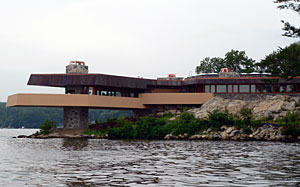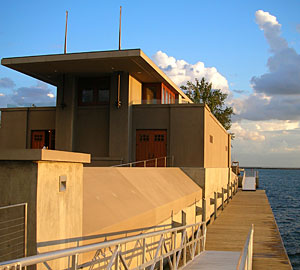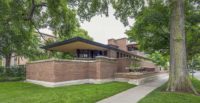|
Though Frank Lloyd Wright passed away decades ago—April 9 will mark the 50th anniversary of the death—two separate projects completed in recent years in New York owe their designs to the legendary architect.
Massaro House
Toward the end of his life, after enduring a few boom-bust cycles, Wright reached a remarkably productive stage of his career, often noting that he couldn’t shake buildings out of his sleeve fast enough. In 1952, the 85-year-old Wright designed a house and 300-square-foot guesthouse for Petre Island, located in Lake Mahopac, approximately 50 miles north of Manhattan. The guesthouse was built, but the architect’s plans for the main house—with its daring cantilevers and remote site—exceeded the client’s $50,000 budget, so it remained unbuilt.
More than four decades later, sheet-metal magnate Joseph Massaro purchased the 10-acre Petre Island. He also acquired Wright’s drawings for the main house. In 1996, Massaro met Thomas A. Heinz, AIA, a Chicago-based architect and Wright scholar, who at the time was cataloguing Wright’s projects for a field guide. Massaro hired Heinz to realize the house, leaving the architect to decipher five 5-by-8-inch preliminary pencil drawings. Heinz traveled to the Getty Center, in Los Angeles, where he looked at correspondence between Wright and the client, attempting to place the drawings into a broader context.
The resulting 5,000-square-foot concrete house, completed in 2007 and now referred to as the Massaro House, sits on a sloped, rocky site on the island’s edge. It cantilevers 78 feet over the water, resembling the form of a pier. In keeping with Wright’s idea of “organic architecture,” the house is both a bold, formal object, and one that melts into the landscape. Underscoring this effect, a large granite stone emerges from the floor of the house’s entry area. Heinz used Wright’s original concrete formula, along with his original furniture designs.


West Side Rowing Club
Hundreds of miles to the west, in Buffalo, the West Side Rowing Club constructed a boathouse that Wright designed in 1905. The group raised $5.5 million to build the two-story, 9,460-square-foot structure, completed in 2007. Wisconsin-based architect and Wright apprentice, Anthony Puttnam, oversaw the project, precisely following the original drawings, which were acquired from the Arizona-based Frank Lloyd Wright Foundation. In keeping with the architect’s penchant to cantilever, the roof extends dramatically over the concrete building’s entryway. Perched on the Niagara River, it looks every bit the part a Wright building.
Other Projects
Recently, there have been several other projects in New York related to Wright’s work, including renovation of the Darwin D. Martin House complex in Buffalo (and construction of a Toshiko Mori-designed pavilion for the site); restoration of Graycliff, an estate in Derby designed by Wright in the 1920s; and construction of a Wright-designed mausoleum in 2004 at the Forest Lawn Cemetery in Buffalo.
“As an admirer of Wright’s work, I’d like to see more of it built,” explains Debra Pickrel, who, with Jane King Hession co-authored Frank Lloyd Wright in New York: The Plaza Years, 1954-1959 (Gibbs Smith, 2007). “There is great motivation to see his designs realized. Everyone likes to imagine.”
Mark your calendars: From May 15 to August 23, the exhibition Frank Lloyd Wright: From Within Outward will be on view at the Solomon R. Guggenheim Museum, in New York. The timing of the show is significant: the Wright-designed Guggenheim Museum was completed 50 years ago (in October 1959), and April 9 marks the 50th anniversary of the architect’s death. For more information, visit the museum’s Web site. |




Post a comment to this article
Report Abusive Comment